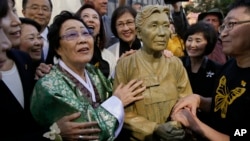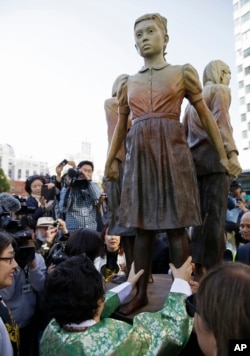The U.S. city of San Francisco has unveiled a new statue to honor Asian women during World War II who were forced to work in brothels run by the Japanese Imperial Army.
The statue of Asia’s “comfort women” is the latest of dozens of such statues worldwide, but the first in a major U.S. city, and has provoked opposition from some in the Japanese community.
San Francisco’s Korean, Chinese and Filipino communities established the memorial, which was dedicated Friday in the city’s Chinatown district.
Eighty-nine-year-old former comfort woman Yongsoo Lee came from South Korea for the ceremony and said she would continue to campaign for such statues until there is one in Japan’s capital.
Japanese officials have long pushed back against the creation of such statues, the first of which appeared outside the Japanese Embassy in Seoul in 2011.
U.S. media reports say the Japanese Consulate in San Francisco tried to block the installation of the latest statue. Other statues in the U.S. have also provoked controversy, including a recent lawsuit seeking the removal of a comfort-women statue in Glendale, California, that went all the way to the Supreme Court. The court in March declined to hear the case, and the statue remains in place.
The San Francisco Chronicle reported that the sculptor of the San Francisco statue, Steven Whyte, who was selected by the San Francisco Arts Commission, received more than 1,000 angry emails and phone calls demanding he stop work on the project.
Whyte’s 10-foot statue, “Women’s Column of Strength,” depicts three girls — one Chinese, one Korean and one Filipina — standing on top of a pedestal, holding hands. On the ground below them stands a grandmother, which symbolizes survivors still hoping for justice.
Historians say that as many as 200,000 women and girls from countries that Japan occupied, including Korea, China and the Philippines, were forced to work in brothels run by the Japanese military. Survivors began to speak publicity about their experiences only in the 1990s.
Proponents of the statues say the memorials help people remember the victims, who have mostly been forgotten. Those in the Japanese community who oppose the statues say they single out Japan for wartime atrocities that were also committed by other countries.
Japan reached an agreement with South Korea in 2015 to pay reparations to surviving South Korean victims.







